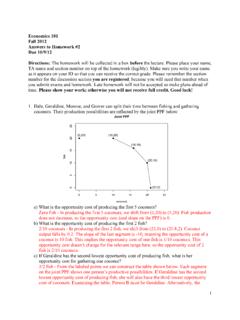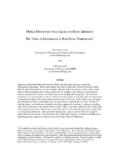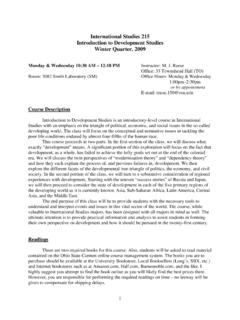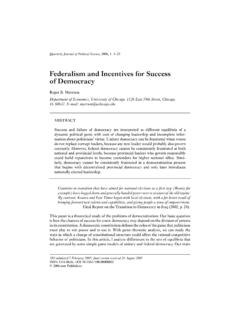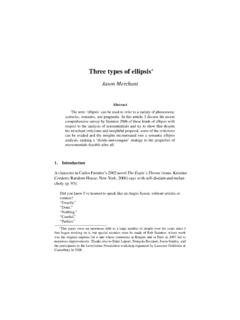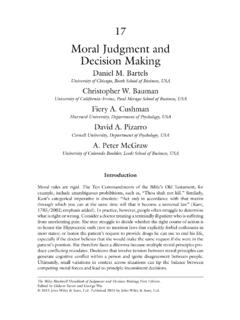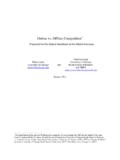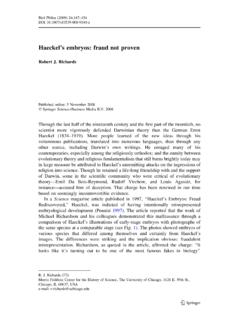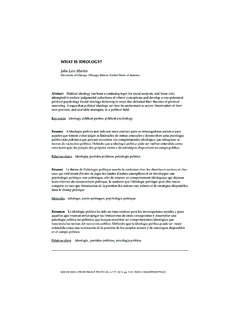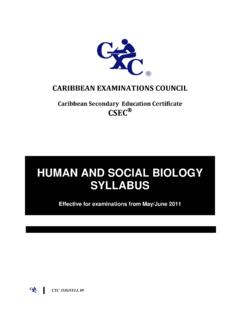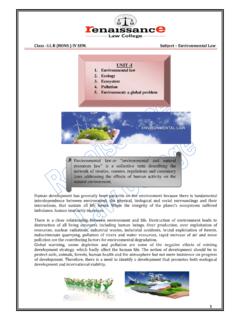Transcription of Life history tradeoffs and the evolutionary biology of aging
1 OUP CORRECTED PROOF FINAL, 04/27/2013, SPiEvolution and Medicine. First Edition. Robert L. Perlman Robert L. Perlman 2013 by Oxford University Press. 5 life history tradeoffs and the evolutionary biology of aging Introduction We commonly talk about our lives in terms of the life course or life cycle. Although each of us goes through a life cycle only once, there is a continuity of life cycles from generation to generation. Some biologists view life cycles as the fundamental units of biological organiza-tion and think about evolution as the evolution of life cycles ( Bonner 1993 ; Sterelny and Griffi ths 1999 ). evolutionary life history theory provides a framework for understanding how natural selection has shaped life cycles in ways that optimize reproductive fi tness ( Charnov 1993 ; Stearns 1992 ). life history theory provides a coherent view of the entire human life cycle and is especially important for medicine because it underlies the evolutionary theory of aging .
2 organisms require nutrients and other resources oxygen, water, heat, shelter, other organisms , etc. to survive and reproduce. Th ey can acquire these resources directly from their environments or indirectly from others, most often their parents, and they have to allo-cate these resources, as well as their time, among a handful of tasks, including growth and development, reproduction, prevention and repair of bodily damage, external work, and stor-age. Prevention of bodily damage includes responding to and countering threats and stresses. And reproduction does not simply mean the energetic cost of having babies. It refers to all of the costs of producing and maintaining secondary sexual characteristics and fi nding mating partners, as well as bearing, raising, and providing resources for their off spring. In demo-graphic terms, organisms use resources to increase survival and to increase fertility.
3 life his-tory theory is a theory of the ways in which natural selection has shaped the physiological and behavioral mechanisms that regulate the acquisition and allocation of these resources over the life cycle. Th e human life cycle can be divided into several more or less distinct stages prenatal, infant (nursing), post-weaning dependent child, puberty and adolescence, sexual and repro-ductive maturity, and post-reproductive life . Th ese stages are distinguished by diff erences in the ways we acquire and use nutrients and other resources. Natural selection has adjusted the timing of these stages as well as our activities in them. It has modulated the duration of gestation and of nursing, our overall growth rates and the growth of individual organs during childhood, the timing of puberty and the age at which we reach reproductive maturity, how OUP CORRECTED PROOF FINAL, 04/27/2013, SPi52 Evolution and Medicinefrequently we reproduce and how many children we have each time we do so, the age at which we cease reproduction, and the length of our post-reproductive lives ( Stearns et al.)
4 2008 ). Hormones mediate many of these life history decisions and so they play a central role in life history theory. Each of these life history decisions involves tradeoff s or compromises. With respect to the duration of gestation, for example, there are advantages for fetuses to remain in utero, since the uterus provides a protected environment in which they can grow and develop. As fetuses grow larger, however, they become a bigger nutritional burden on the mother and suff er an increased risk of complications during labor and delivery. Th e timing of labor and delivery is apparently the optimal compromise between these two competing demands ( Ellison 2001 ). Th e age at which we reach puberty and sexual maturity also involves trade-off s. We need time to develop physically, psychologically, and socially to the point that we can bear and care for children.
5 On the other hand, we need to become sexually mature and have the opportunity to reproduce when we are still young enough that we can have and raise our children before we re likely to die. Yet again, there is a tradeoff between fertility and the survival of off spring that we discussed in Chapter 2, because the more children we have, the fewer resources we can allocate to each and the greater is their risk of dying before they reach reproductive maturity. Presumably because they are regulated by pleiotropic genes, many life history traits are correlated among primate or mammalian species. For example, the duration of childhood or juvenility among primates is correlated with their life expectancy ( Leigh 2001 ). Th ere may be tradeoff s among suites of traits that evolve together. Moreover, as we shall discuss later, our life history strategies are not fi xed but can change in response to environmental signals we receive during development.
6 Th e range of life histories or other phenotypes that can be pro-duced by organisms of a single genotype developing in a range of environments is known as their norm of reaction ( Gilbert 2001 ). Natural selection does not act simply to optimize fi tness in one specifi c environment. It modulates the norm of reaction to optimize fi tness across the diversity of environments that a species has encountered during its evolutionary history . Our developmental fl exibility and our ability to survive and reproduce in diff erent environments may limit our adaptation to any one specifi c environment. Th e human life cycle resembles the life cycles of other great apes, especially chimpanzees, but has a number of special features that presumably arose during the past 6 million years or so, since the time the hominin ( human ) lineage diverged from the lineage leading to chim-panzees ( Robson et al.)
7 2006 ). We have a slightly longer gestation period (9 vs 8 months) and lower rates of twinning than do chimpanzees. Women in many traditional societies nurse their babies for 2 3 years, whereas chimpanzee mothers nurse for 4 5 years. Juvenile chim-panzees are able to acquire much of their own food by the time they are weaned and typically leave their mothers 2 3 years after weaning. We have a much longer period of childhood or juvenility, when children are no longer nursing but are still dependent on parents or others for food and survival. Because of this long period of childhood dependence, women typically have to care for several dependent children at the same time. Women have their fi rst babies at a considerably older age than do chimpanzee females (19 20 vs 13 14 years). Because of OUP CORRECTED PROOF FINAL, 04/27/2013, SPiLife history tradeoffs and the evolutionary biology of aging 53 earlier weaning, women in natural fertility societies, in the absence of contraceptives or family planning, then have babies at shorter intervals than do chimpanzees (3 4 vs 5 6 years).
8 Finally, although both women and chimpanzee mothers can have off spring until their early forties, we have much longer post-reproductive lives: chimpanzee females have life spans of 50 55 years while women have life spans of 80 or longer. Th e special features of the human life cycle must have been shaped by the environments in which ancestral humans evolved, including among other factors the composition of ances-tral human diets ( Kaplan et al. 2003 ). Chimpanzee diets are rich in foods such as fruits and piths (the soft, fl eshy material in the stems and branches of plants), which are relatively easy to obtain. Although we also eat fruits, they are a smaller component of our diets. We have evolved to eat a variety of energy-rich but diffi cult to acquire foods, such as nuts, seeds, roots, and meat. It takes a long time for children to acquire the skills needed to collect enough of these foods to be nutritionally self-suffi cient.
9 After they acquire these skills, however, adults can gather or hunt much more than they themselves need. Our long period of childhood dependence is made possible by the contributions of adults to the nutritional, educational, and social support of children. Th ere are controversies over how long it takes children to acquire the skills they need to become self-suffi cient and over the relative roles of fathers, grandmothers, and other adults in helping to provision dependent children ( Hawkes 2004 ). Th ese aspects of child develop-ment and childcare may well diff er in diff erent societies. Despite these unresolved questions, this ecological perspective provides a plausible and attractive way of understanding the evo-lution of the human life cycle. Evolution of a prolonged childhood, which would have given children the opportunity to gain the knowledge and skills they needed to become self- suffi cient, would have been accompanied by evolution of a longer life span, which gave adults more time to provision their dependent children.
10 Long before the recent advances in medi-cine and public health that have extended our life expectancy, many of our ancestors who survived infancy and childhood went on to have long lives. Even in a population with a life expectancy of only 20 years, about a quarter of the population lives until age 50 ( Coale 1974 ). 5 . 2 Th e causes of death change through the life cycle Diff erent stages of the life cycle are characterized by diff erent patterns of disease and death. Recall that the major causes of death in infancy and childhood include congenital malforma-tions and chromosomal abnormalities, genetic diseases, developmental defects, infectious diseases, and nutritional defi ciencies. Th e high mortality of adolescent and young sexually mature men is due in large part to accidents, violence, and suicide. Deaths due to cardiovas-cular diseases and most cancers increase from about age ten onward but these diseases don t become the leading causes of death until around age 40, near the end of our period of repro-ductive maturity.
